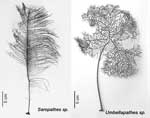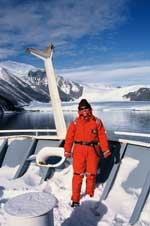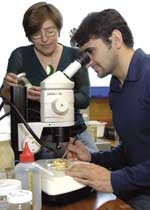
Visiting scientists advance knowledge of marine biodiversity
The NIWA Invertebrate Collection (NIC) benefitted from the visits of several overseas specialists in 2006; they came to NIWA to study cyclostome bryozoans, black corals, and Antarctic polychaetes.
Sole survivor
Hornera robusta, a cyclostome bryozoan, magnified through scanning electron microscopy
Dr Paul Taylor (Natural History Museum, London) came in February to sort, label, and identify species of Cyclostomata. This ancient bryozoan order is the sole survivor out of five orders of the class Stenolaemata that was globally abundant during the Paleozoic. Today, cyclostomes constitute only about 10% of living bryozoans. A few cyclostomes, especially New Zealand’s endemic Cinctipora elegans, provide important habitat for other marine life, especially on the continental shelf off Otago and in Foveaux Strait (where the C. elegans habitat is believed to enhance survival of Bluff oysters). Cyclostomes are a taxonomically difficult group and Paul is the acknowledged global authority. The approximately 700 specimens in NIC are from a diverse range of taxa, including new species and genera additional to those already known. It appears that New Zealand’s cyclostome fauna of about 125 species is the most for any region of the world, but this may reflect the high number of samples available for study. The new records will be added to NIWA’s database.
Black corals revisited

Dr Dennis Opresko (Oak Ridge National Laboratory, USA) arrived in June to continue his taxonomic studies of New Zealand Antipatharia. Since his last visit in 1999, NIWA’s black coral collection has greatly expanded owing to continuing offshore faunal surveys, especially on seamounts. During his 1999 visit, Dennis identified 35 species in the collection, a substantial increase on the 10 species previously known to live in the New Zealand EEZ. The combined number of species now documented in our collection, as well as that of Te Papa, exceeds 50. (The exact number can not be determined until the material has been studied in detail.) Considering that the known Indo-Pacific antipatharian fauna consists of about 150 species, the New Zealand collections are significant in both size and diversity. Dennis reports that there may be 10 or more new species in the NIWA collection.
This collection also contains some rare taxa. In 1999, Dennis found several specimens of a form previously known from only a single specimen and for which he later established a new genus called Saropathes. During his recent visit, he found a specimen belonging to another rare and unusual genus, Umbellapathes. This is the first occurrence of this genus in the southern hemisphere; previous records have been restricted to the North Pacific. This coral forms a long stalk topped by a crown of branching pinnules.
Dennis’s preliminary studies of the NIWA collection have provided considerable support for the major changes that were made to antipatharian classification, and it is hoped that these changes will encourage further work on these unique corals by scientists here in New Zealand.
The worms that came out of the cold


Polychaete expert Dr Américo Montiel (Instituto de la Patagonia, Universidad de Magallanes in Punto Arenas, Chile) arrived later in the year to work with benthic ecologist Kerstin Kröger on Antarctic polychaetes.
These ‘bristle worms’ (polychaeta: many bristles) are a ubiquitous group of mainly marine invertebrates. They are characterised by their parapodia (‘pseudo-feet’), which are used for locomotion, and a pronounced head bearing tentacles, palps, and often eyes. Polychaetes occur mainly in soft–sediment benthic habitats from shallow coastal waters to abyssal depths, where they play a very important role ecologically, dominating in terms of number of species as well as individuals. They occupy many ecological niches, contribute to many benthic processes, and are important for marine food webs as prey (for example, for molluscs, fish, wading birds), and as predators in their own right.
In Antarctica, polychaetes are especially important because they contribute largely to the overall marine biodiversity. Notwithstanding their high biodiversity (estimates of the number of species in Antarctic shelf waters range between 650 and 800) and ecological importance, Antarctic polychaetes are a poorly studied group, especially with regard to their distribution patterns, biogeography, and their role in Antarctic benthic ecosystems.
For about 40 million years, the Antarctic shelf fauna has been isolated from the adjacent shelf environments by cold deep waters and the circum-Antarctic current system. The shelf fauna (including polychaetes) was thought to show a circum–Antarctic distribution, based on few widely separated locality records; however, suggestions of geographic subdivisions have emerged. Lack of comprehensive data sets on faunal composition from a number of regions has impaired continent–wide species-level examinations to answer questions of circum–Antarctic or subdivided distribution for any Antarctic macrofaunal group, and polychaetes are by no means an exception.
In order to shed more light on the question of circum-Antarctic or subdivided distribution, Américo and Kerstin are collaborating on a comparative analysis of Weddell and Ross Sea polychaete data with support from the Royal Society’s ISAT linkages fund. They are looking for differences and commonalities between the Weddell Sea and Ross Sea polychaete faunas in order to provide insights into the biodiversity and zoogeography of Antarctic polychaetes.
Américo collected polychaetes in the Weddell Sea on two research voyages on the German research icebreaker FS Polarstern in 1998 and 2000 and has returned to the ice for the 2006 season. Kerstin participated in NIWA’s 2004 BioRoss voyage to the northwestern Ross Sea (Cape Adare to Cape Hallett; Balleny Islands), where she collected more than 4000 polychaete specimens.
First results of their comparison indicate that the faunas are – despite a certain degree of overlap – significantly different, with the Weddell Sea fauna showing a higher species richness. Américo also used his visit to NIWA to initiate the exchange of biological specimens for taxonomic, phylogenetic, and zoogeographical studies between NIWA’s Invertebrate Collection and the Instituto de la Patagonia.
For further information about the visits by Dr Paul Taylor and Dr Dennis Opresko, contact: Dr Dennis Gordon, 0-4-386 0388, [email protected]
To learn more about Dr Américo Montiel’s visit, contact: Dr Kerstin Kröger, 0-4-386 0353, [email protected]
NIC goes online
New Zealand lies in the southwestern Pacific, a region that has the world’s highest species diversity amongst many marine invertebrate groups. The NIWA Invertebrate Collection, sited at Greta Point in Wellington, is fortunate to hold a significant representation of New Zealand’s marine biodiversity.
The NIC specimens come from about half a century of marine taxonomic and biodiversity research in the New Zealand region, the southwestern Pacific, and the Ross Sea. There are representatives from almost all invertebrate phyla found in the New Zealand region plus unsorted samples and unidentified specimens. The collection is arranged taxonomically and holds more than 100 000 containers, holding several million specimens from more than 10 000 benthic and sediment stations. NIC is of national and international significance because these samples are essential in determining the evolutionary and biological relationships of the New Zealand marine biota in relation to the rest of the world.
The most precious part of any scientific or museum collection is the type material. A holotype is the single, unique specimen on which taxonomists base their description of a new species. A holotype is the physical object that allows confirmation or ‘proof of hypothesis’ for a species or record. These types are the material evidence of the reality of a species and, as in the case of identified specimens, of the occurrence of a species in New Zealand. The NIWA type collection contains more than 2350 type specimen lots. Many species new to science are added each year, including the material on which the NIWA Biodiversity Memoir monographs are based. All types are entered into the collections register, a Specify database. The associated data, such as author, publication year, sample depth, longitude, latitude, and taxonomic hierarchy, are all checked and updated. This invaluable type material resource is now available on the NIWA website, where it can be searched by these categories. In the long term, all of NIC registration data will be made available online.
To investigate the type material, click on ‘Search the collection’ at: www.niwa.co.nz/our-services/online-services/nic/search
For further information, contact: Dr Anne-Nina Lörz, 0-4-386 0900, [email protected] Kareen Schnabel, 0-4-386 0862, [email protected]
or see: Lörz, A-N.; Bruce, N. (2004). NIWA’s Marine Invertebrate Collection: a treasure for biodiversity research. Water & Atmosphere 12(3): 21.
